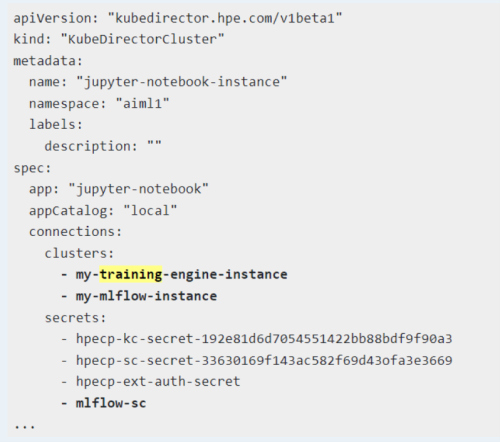Tutorial: KubeDirector Training and Serving
Starting with HPE Ezmeral Runtime Enterprise 5.5.0, the KubeDirector training and deployment applications are deprecated, and are unavailable for creation through the HPE Ezmeral ML Ops UI. However, you can still create and use KubeDirector training and deployment applications with YAML files. This tutorial provides instructions on deploying Kubedirector Training and Kubedirector Serving applications with YAML files in HPE Ezmeral ML Ops.
If you have not done so already: Before beginning this tutorial, download the KubeDirector transition tutorials zip file, which contains sample files for all of the included KubeDirector tutorials.
Instantiate a KubeDirector Training Application
Name: Name of the training instance.Namepsace: Name of the Tenant namespace.Spec.connection.secrets: Tenant secrets that are included. To fetch and update the secret values, use the following command:kubectl -n <namespace> get secretsRequests/limits: You can edit this value for CPU, memory, or GPU as needed.Roles.podLabels: To enable DataTap for all node roles, set:hpecp.hpe.com/dtap: "hadoop2"
- After you have populated the YAML based on your cluster configuration, apply
the YAML towards your tenant
namespace:
Kubectl -n <tenant_namespace> apply -f training-instance.yaml - For each training instance, there are two pods. One pod services the APIs, and the other acts as a load balancer. Ensure both pods are in a running state. Once successful, the training instance now appears while creating a notebook cluster.
Instantiate a Kubedirector Model Serving Application
Name: Name of the deployment instance.Namepsace: Name of the Tenant namespace.Spec.connection.secrets: Tenant secrets that are included. To fetch and update the secret values, use the following command:kubectl -n <namespace> get secretsRequests/limits: You can edit this value for CPU, memory, or GPU as needed.Roles.podLabels: To enable DataTap for all node roles, set:hpecp.hpe.com/dtap: "hadoop2"
- After you have populated the YAML based on your cluster configuration, apply
the YAML towards your tenant
namespace:
Kubectl -n <tenant_namespace> apply -f deployment-instance.yaml - For each training instance, there are two pods. One pod services the APIs, and the other acts as a load balancer. Ensure both pods are in a running state. Once successful, the training instance now appears while creating a notebook cluster.
Include the Training Clusters in the Kubedirector Notebook
You can include Training clusters in the Kubedirector notebook to run Training-related magic functions.
- Log in to the HPE Ezmeral Runtime Enterprise web UI.
- Select Dashboard.
- Select the HPE Ezmeral ML Ops tenant.
- Select the notebook and select launch.
- Edit the YAML file and add the training cluster:

